People tend to know two things about blue whales: They are huge and their carcasses are terribly smelly if they wash ashore.
What people don't know is that they are surprisingly agile given that they are the heaviest creatures on Earth, growing up to 32 metres in length and weighing up to 150 tonnes. Despite their size, they can travel at maximum speeds of 32 to 36 kilometres an hour.
"People think of blue whales as these big, bloated, distended, round guppies," said Jack Lawson, a research scientist in the marine mammal section at the federal Department of Fisheries and Oceans.
"But when you see them in the water they are almost like long snakes with a fluke on the end."
Dr. Lawson was one of many researchers who had the chance to study one of these gentle giants when nine blue whales died off the western coast of Newfoundland in 2014.The exact cause of death remains unknown but scientists believe the whales were trapped when ice changed direction due to swirling, powerful winds. The behemoths, who were close to shore likely trying to feed, either got crushed between ice floes and the shore or drowned by being stuck under the ice with nowhere to breathe.
Three of them floated to land and now the bones of one of them are about to be unveiled to the public in a display at the Royal Ontario Museum in Toronto.
Watch the whale’s journey from a Newfoundland beach to a Toronto museum
Step 1: Assessing
Burton Lim was one of the ROM scientists sent to Newfoundland after one of the whales (now named Blue) sailed into Trout River, Nfld.
Initially Blue looked like an inflated balloon as the waves pushed it onto the town's beach (near its boardwalk).
"They stay warm for a few days after they are killed," said Dr. Lawson, pointing out that blue whales are warm-blooded and well insulated. "So they kind of cook."
This cooking resulted in gases like methane and carbon dioxide building up in the decaying body, filling her voluminous throat grooves and giving her that puffed-up look.
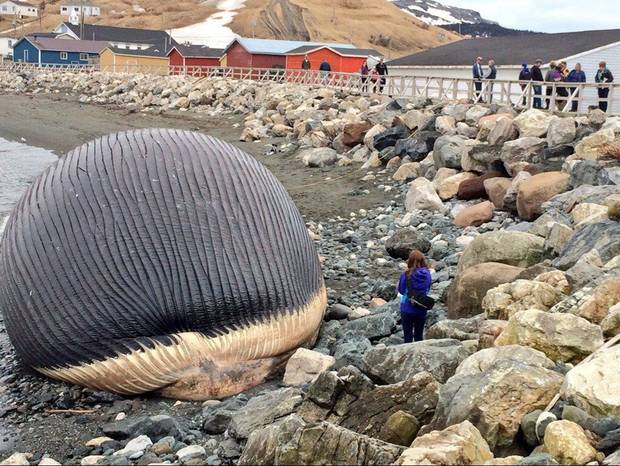
The whale in Trout River on April 27, 2014.
NTV NEWS, DON BRADSHAW/THE CANADIAN PRESS
But by the time Dr. Lim arrived, Blue had deflated and was lying on the beach upside down. Quickly the ROM's team realized that they couldn't do the dirty, putrid work of de-fleshing the whale in Trout River, so they found Woody Point, where there was a beach close by to an unused fish processing plant.
"We didn't want to take Trout River's problem and just give it to Woody Point," said Dr. Lim. So Woody Point had a "special town meeting" and barely approved the transfer 3-2.

TRISH McALASTER/THE GLOBE AND MAIL
Step 2: Towing
But getting to the new site wasn't so easy because of a sandbar. The team devised a two-pronged solution. First, a couple of small boats tugged Blue off the beach and over the sandbar, then a fishing trawler took up the tow and brought the whale over to Woody Point.
The whole journey took two hours (it only takes 17 minutes to drive between the small towns) and once at the new beach, the team needed a tractor-trailer and a dump truck.
"They had to link up two vehicles – cause the whale was too big – to pull it up the boat ramp," said Dr. Lim.

ROYAL ONTARIO MUSEUM VIDEO

ROYAL ONTARIO MUSEUM VIDEO
Step 3: Flensing
Next up was the gory task of "flensing," the term for taking off the whale's flesh. The ROM team was armed with three types of knives. Their main instrument was a specially made knife that had a sharp, smooth blade that was around 45 centimetre long, with a 60 centimetre-long handle. Also used were two other knives you might have at home: a chef's knife and a smaller deboning knife.
"We did what the early whalers did," said Dr. Lim, explaining their team had studied old whaling books and learned how to section up the flesh in one-metre-by-one-metre swaths to methodically cut 15 cm in the skin and blubber and then peel it away with meathooks.
They were also able to hoist up parts with a front-end loader and let gravity help out with the flensing. In all, it took six 12-hour days for the team of 10 to remove most of the flesh.

paul daly/the canadian press
Step 4: Transport
Once the bones were free of the body, the team labelled them using wire and poker chips and then lifted the ones they could by hand to load into three awaiting tractor-trailers.
Heavier bones, like the jawbone that is about 5.5 metres and weighs 365 kilograms, were lifted by a forklift.
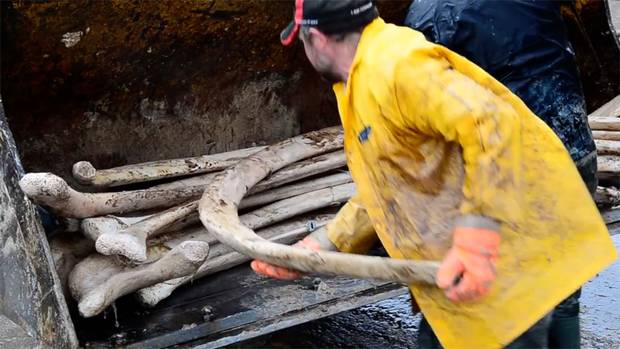
royal ontario museum video
Inside the trailers was just some plastic lining to help collect the oil that was still oozing off of the bones.
Then the caravan of smelly, still a little meaty bones drove the 31 or so hours from Woody Point to Trenton, Ont.
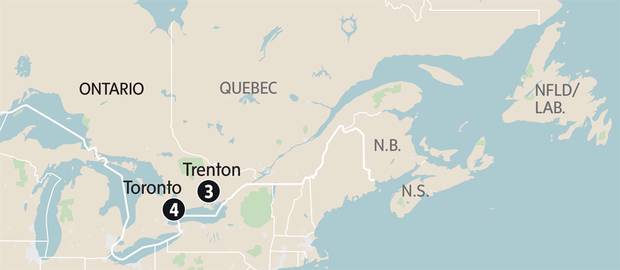
TRISH McALASTER/THE GLOBE AND MAIL
Step 5: De-fleshing
Upon arrival, the team cut holes into the tops of the trailers and started filling them with six dump trucks worth of manure mixed with sawdust.
"They couldn't reuse them anyway because of the whale stench and oils," explained Dr. Lim.
This compost mix also contained weeping tiles so the bacteria could get the air it needed to eat off the last bits of meat.
The bones were buried for 1.5 years and emerged cleaner but far less white. They had gone in quite pale but leeched in some of the brown from the compost over time.

SAMANTHA PHILLIPS/ROYAL ONTARIO MUSEUM, 2015
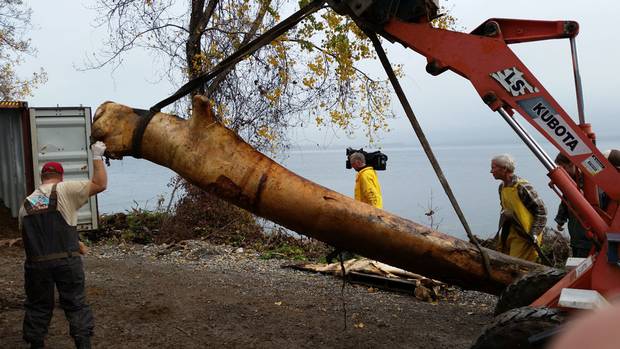
SAMANTHA PHILLIPS/ROYAL ONTARIO MUSEUM, 2015
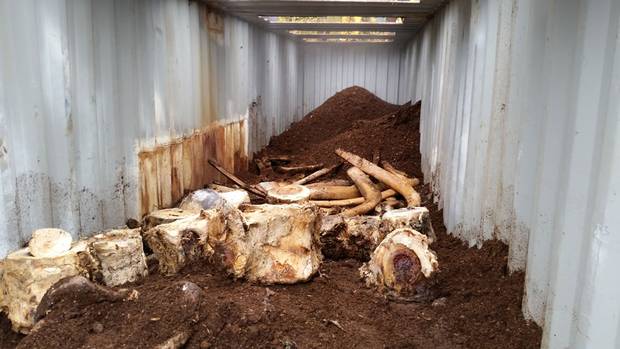
SAMANTHA PHILLIPS/ROYAL ONTARIO MUSEUM, 2015
Step 6: Degreasing
Even without flesh, there was still more oil to be removed, as it is found inside the bones as well.
"The oil seeps out in the compost but it's the degreaser that finishes the job," said Peter May, the president and founder of Research Casting International.
RCI (one of the ROM's partners in this project) was involved in all steps of the process, but the degreasing stage came to them. They set up the above-ground pool in one of their warehouses and sprayed all 350 bones with a soapy water.
"It's sort of like washing dishes," said Dr. Lim. "If you just use water, the oil doesn't get out. You need the soap to free it. Then you can wash it off with water."

SALLY McINTYRE/ROYAL ONTARIO MUSEUM, 2016
Step 7: Re-articulation
The next step for Mr. May's team was to put the pieces of the skeleton back together again and decide on a pose.
They settled on mating position called "coursing," where Blue's spine is subtly twisted.
"When males and females get together for mating purposes, there can be competition," said Dr. Lim. "It's a very fast, almost violent, swimming motion."
To get the skeleton to stay in the air, the RCI team also created the metal supports to the proportions of the five-metre tall room in the ROM.

FATIMA ALI/ROYAL ONTARIO MUSEUM

FATIMA ALI/ROYAL ONTARIO MUSEUM
Step 8: Mounting
Once this was done, Blue was disassembled again and brought to the museum and reassembled.
Some of the bones were so big – like the casting of the skull, which is six metres long and three metres wide – that it took some Tetris-master skills to get it through doorways and into the display area.

Brett Crawford checks the spine mounting of the blue whale at the Research Casting International warehouse.
MELISSA TAIT/THE GLOBE AND MAIL
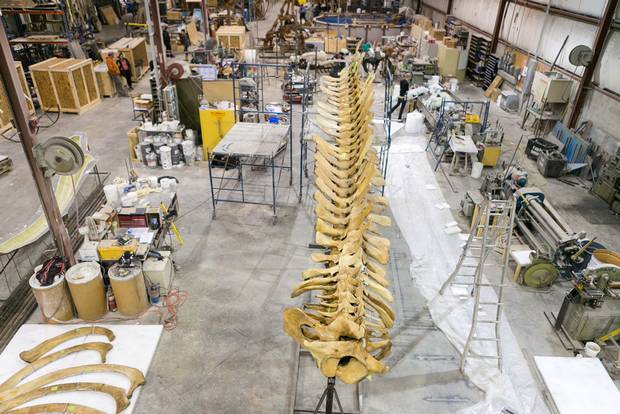
About two thirds of the spine mounting at the RCI warehouse took 30 minutes.
MELISSA TAIT/THE GLOBE AND MAIL

Darian Mayer demonstrates how a rib bone will be mounted to the spine.
MELISSA TAIT/THE GLOBE AND MAIL
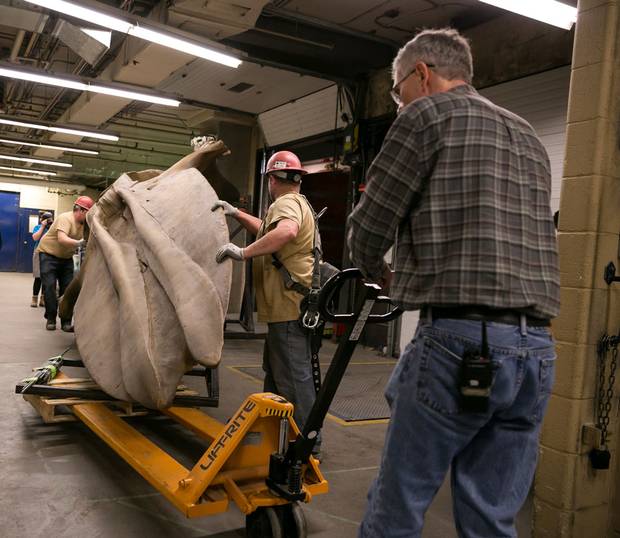
The temporary cast of the whale skull was a tight fit through the loading dock at the ROM. The actual skull is still going through the degreasing process and will replace the cast when it’s completed.
MELISSA TAIT/THE GLOBE AND MAIL

Deanna Way touches up a section of the spine as the RCI team begins the mounting process at the ROM.
MELISSA TAIT/THE GLOBE AND MAIL
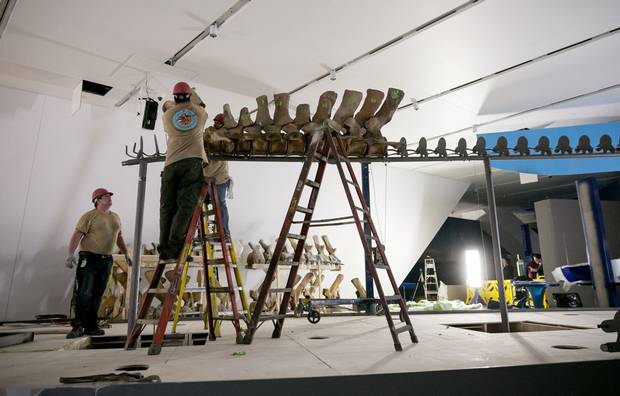
The RCI team mounts the spine in the exhibition space.
MELISSA TAIT/THE GLOBE AND MAIL
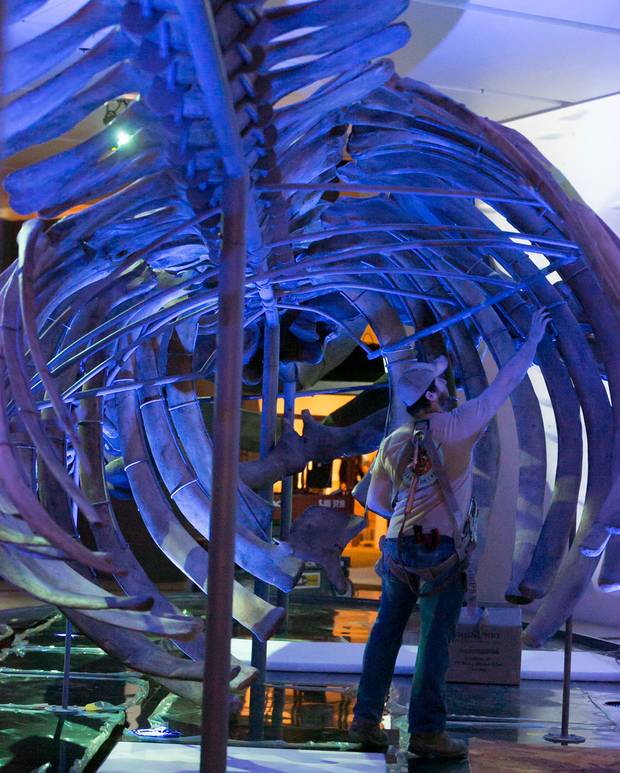
Darian Mayer checks the rib cage part way through the installation.
MELISSA TAIT/THE GLOBE AND MAIL
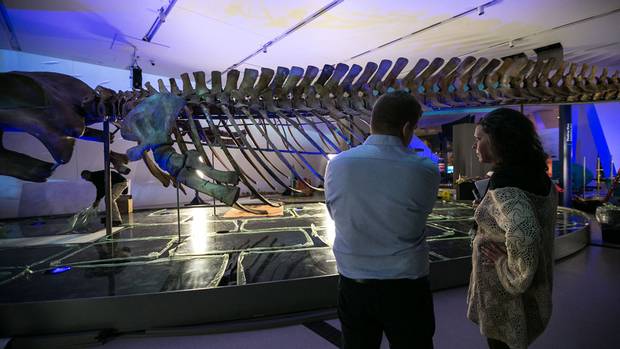
The ROM’s display of the skeleton is open to the public on Saturday.
MELISSA TAIT/THE GLOBE AND MAIL
BIOLOGY
The body aquatic: What happened to the rest of the whale?
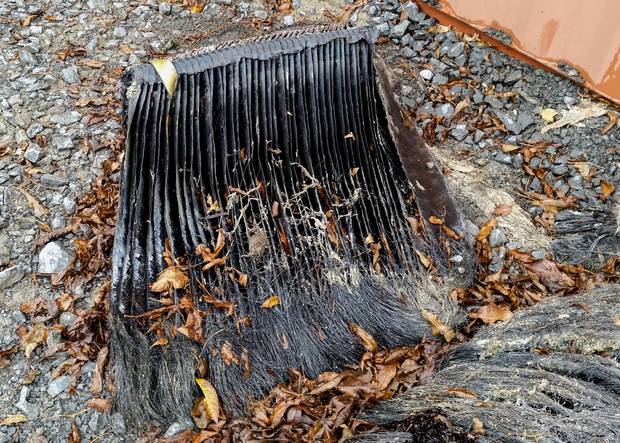
Stephanie Phillips/ROYAL ONTARIO MUSEUM
Balleen
One of the non-bone features that was preserved from Blue was her baleen, the curtain-like keratin material that lines a whale's mouth and filters out water but traps krill.
Because it's not bone, it wasn't oily but once dry, it warped.
So while the bones were being degreased, Blue's baleen was resoaked with water, flattened out and polished.

MELISSA TAIT/THE GLOBE AND MAIL
Skull
Currently, Blue's skull is a casting of the original. This is because it is taking much longer than anticipated to fully degrease.
Part of the challenge with the skull is that it wasn't flensed because the bones were a little crushed, possibly by ice. Instead, it was transported with flesh to the manure burial in Trenton.
Dr. Lim expects the real skull bones to join the rest of Blue's body in a few weeks.
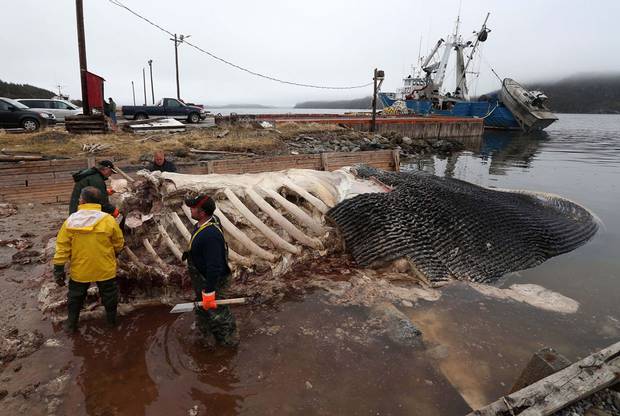
The whale in Woody Point, Nfld., on May 11, 2014.
PAUL DALY/THE CANADIAN PRESS
Biowaste
So what happened to all that discarded flesh?
"We'd load up the skin, blubber and flesh in the front-end loader and that would dump it in the dump truck," said Dr. Lim. "Once that was full, they'd take it to the landfill."
It wasn't any old landfill either. They had to dig one specifically for this biowaste and line it with crushed limestone as a neutralizer to deal with the huge amount of decomposition and its byproducts.
About 60 to 70 tonnes of skin, blubber and flesh was disposed.
ENVIRONMENT
Conservation: The bigger picture
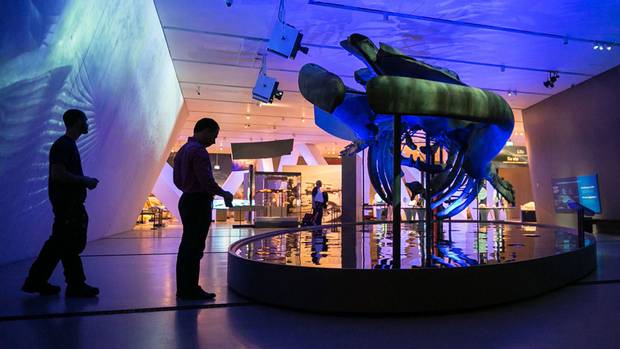
Security staff install motion detectors below the blue whale skeleton as the final touches are made on the exhibition.
MELISSA TAIT/THE GLOBE AND MAIL
Before the whaling industry took to the seas in the 1800s, there were many more blue whales. Now, they are on both a global and Canadian list of endangered species and knowing the exact number that remain is a bit of guessing game.
"We have no idea how many are there," said Dr. Lawson , adding that best estimates suggest about 200 to 400 in the northwest Atlantic area near Newfoundland, Labrador and Nova Scotia.
What Dr. Lawson does know is that the region's blue whales seem to be having very few babies and the loss of three adult females (one of them being Blue) in 2014 would have made repopulation efforts worse.
Dr. Lawson's team is working on identifying "critical habitats" in the region to help the species in the hopes of maybe one day turning some of these spots into federal Marine Protected Areas.
"The more people know about the threats to blue whales, the more they'll understand," he said. "And perhaps support the government when it moves toward protecting areas."
The ROM's Out of the Depths: The Blue Whale Story opens to the public on March 11 (rom.on.ca).
OCEAN LIFE: MORE FROM THE GLOBE AND MAIL



